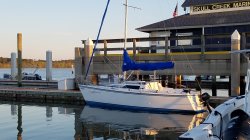
Student
Mark Howe
San Juan Capistrano, CA, USA
More User info
Crew Level 0
Status: Sailor
Qualified days: 0
Posted 2019, Jul 06 18:47
Since the graphic boat is on Port, to me the green 'woolly' should be above and the red below to match the graphic. If the boat were on stbd having red above would have matched making me happy.

Student
Mark Howe
San Juan Capistrano, CA, USA
More User info
Crew Level 0
Status: Sailor
Qualified days: 0
Posted 2019, Jul 06 19:36
The American vernacular for knock is header. One is being headed when the wind shifts in a direction that heads us off away from our destination. A header on one tack is a lift on the other, so tack.

Student
Mark Howe
San Juan Capistrano, CA, USA
More User info
Crew Level 0
Status: Sailor
Qualified days: 0
Posted 2019, Jul 06 19:49
1. Again I wish the red was below the green for a port tack to match the sail.
2. I wish the graphic would allow for some slight luffing to show that delamination on the inside,
3. I would like a few of the little stall turbulence whirligigs to get up to where the telltales are.

Student
Mark Howe
San Juan Capistrano, CA, USA
More User info
Crew Level 0
Status: Sailor
Qualified days: 0
Posted 2019, Jul 06 20:02
Since we know sailing upwind we are 45° to the true wind +/-, the 30° angle is apparent wind. The only time true and apparent angles coincide is a dead run downwind. A sailboat sails by apparent wind, not true wind.

Student
Mark Howe
San Juan Capistrano, CA, USA
More User info
Crew Level 0
Status: Sailor
Qualified days: 0
Posted 2019, Jul 06 23:37
To me this section indicates going upwind you are most concerned with the inside telltale. The quiz indicates the opposite. Is this a mistake?

Student
ROSS GILLELAND
NORFOLK, MA, USA
More User info
Bareboat Charter Master Level IV
Status: Big Time Sailor
Qualified days: 184
Posted 2019, Jul 20 10:41
Isn't it easier to just set the fairlead so that you are aligning the sheet with this line (a line from the clew to the midpoint of luff). Why is there a need to find the geometric center?

Student
Alan Siegel
Philadelphia, PA, USA
More User info
Crew Level 0
Status: Sailor
Qualified days: 0
Posted 2019, Dec 30 13:08
I understood everything in this module easily except this section. I can easily see how moving the fairlead aft tightens the foot and causes the top of the sail to lose shape to spill wind and how moving it forward reduces tension on the foot, causing a pouch in this area and increases tension on the leach to shape the top of the sail. But I can't seem to figure out how this relates to what tack the boat is on. It seems on one tack you want to spill wind and on another you don't. I can't seem to picture what "twist out and away downwind" looks like and why this would be beneficial on a particular tack vs the opposite when on the opposing tack.

Student
Coby Turner
Bluffton, SC, USA
More User info
Crew Level 0
Status: Sailor
Qualified days: 2
Posted 2020, Jul 03 21:52
The last diagram on the page - indicates that the wind is veering. One of the boats is experiencing backwind - would that mean that the wind would at that moment be coming from back to front? I think I'm confused. Wait. Does backwinding refer to a bigger wind direction than what is occurring around one boat? Help me.

Student
John Gradishar
Newport Beach, CA, USA
More User info
Skipper Level II
Status: Sailor
Qualified days: 34
Posted 2020, Sep 04 16:13
I understand from the test that the apparent wind is always head of the true wind. This makes sense to me if I am on sailing on a close reach or close haul. However if I am sailing on a broad reach or run, I would appear that the apparent wind direction is behind the true wind direction. Can you clarify this?

Student
michael walsh
Stuart, FL, USA
More User info
Crew Level 0
Status: Sailor
Qualified days: 3
Posted 2020, Oct 21 08:04
seems like improper grammar. missing the word , are , after Modern hulls.
Modern hulls manufactured from composite materials that have been designed by engineers using complex computer simulation of stresses.Â